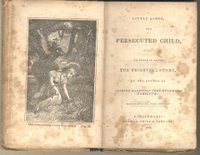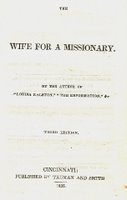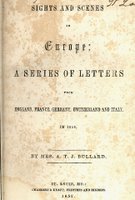 Although this miniature portrait has not yet been firmly attributed to an artist, stylistically, the most likely artist seems to be William Doyle (1787-1828) who worked in Boston.
Although this miniature portrait has not yet been firmly attributed to an artist, stylistically, the most likely artist seems to be William Doyle (1787-1828) who worked in Boston.Initially, it was thought there are some similarities with the work of Nathaniel Rogers, as Rogers tended to make the heads of ladies disproportionately large and the bodies small, but Rogers worked in New York and this sitter came from closer to Boston.
The portrait is inscribed on the reverse "Ann Tuttle Jones 1808-1896 - 1826 date of picture". On the Internet she is referred to as Anne Tuttle Jones Bullard, that is Ann spelled with an "e".

Effectively forgotten for 150 years, Anne deserves belated recognition. In brief, Anne was a published author by the age of 22, writing several fiction books and one non-fiction book, she married and moved westward with her husband Rev Artemas Bullard and so enabling early settlers to take their faith with them. Six of her seven children died in infancy. She was involved with assisting slaves to escape to Canada. In 1850 Anne wrote a series of travel letters from Europe, which were initially published in the "Missouri Republican" newspaper and subequently republished as a book in 1852.

Anne was the grand-daughter of the widow of Captain Isaac Davis, the first officer to be killed in the Revolutionary War, see Minuteman Isaac Davis His widow, Hannah Brown Davis then married Samuel Jones. For an excellent website with comprehensive information about Hannah Brown Davis Jones, (who later remarried again and became Hannah Brown Davis Jones Leighton) see Hannah Brown Davis Jones Leighton
Hannah and Samuel had a son called Samuel Jones who married Anna Tuttle on 21 October 1806, and Anne Tuttle Jones was a daughter of that marriage, born on 31 January 1808 in Acton, Middlesex, MA. On 2 June 1829 at Acton, Anne married Rev Artemas Bullard (sometimes Artemus Bullard) the son of Dr Artemas Bullard who purchased this house in 1805 from Mr Hunt, who had purchased it from the first owner Ebenezer Waters who built it in 1767. The elder Artemas Bullard was a successful medical practitioner was appointed by Governor Strong as surgeon of the local infantry regiment and in 1814 was elected as a fellow of the council of the Massachusetts Medical Society.
On 2 June 1829 at Acton, Anne married Rev Artemas Bullard (sometimes Artemus Bullard) the son of Dr Artemas Bullard who purchased this house in 1805 from Mr Hunt, who had purchased it from the first owner Ebenezer Waters who built it in 1767. The elder Artemas Bullard was a successful medical practitioner was appointed by Governor Strong as surgeon of the local infantry regiment and in 1814 was elected as a fellow of the council of the Massachusetts Medical Society.
Thus Anne would have been a frequent visitor to this house. Anne and Artemas soon moved to St Louis, where Artemas trained men for the clergy. Artemas was related by marriage to the Beecher family, as his younger sister, the author Eunice White Beecher (nee Bullard), later married the Rev Henry Ward Beecher, a well known 19C preacher who attracted large crowds to his sermons, see Henry Ward Beecher . In turn Henry was the brother of the famous author Harriet Beecher Stowe. A younger brother of Artemas was Rev Asa Bullard. He was also an author and wrote particularly for Sunday schools, see Asa Bullard . Writing was therefore common in the Bullard family.
Anne seems to have been the first in the family to be published and had five fiction books printed between 1830 and 1835, which makes her one of the earliest American female authors and she was only 22 years old when the first book was published. For details of her early fiction see Chronological bibliography Then, after a long gap, in 1852 she wrote another fiction book titled; "Matrimony; or Love Affairs in our Village Twenty Years Ago". Interestingly, she was still reluctant to disclose her own name as author, instead calling herself "Mrs Caustic". However, the Preface does refer to her earlier books.
Additionally in 1852 Anne published her travel book as noted below. Although there is as yet no firm evidence, it seems very likely that in the 1840's Anne also wrote anonymously for the Sunday School publications edited by her brother-in-law Asa Bullard, such as "Wellspring", which was first published in 1845. It is understood there are a number of articles in "Wellspring" signed "A B". At first glance this could seem to be Asa Bullard, but they may perhaps be more likely to be Anne Bullard.
This collection now contains four rare copies of Anne's books, three fiction and one non-fiction. The frontispieces of her books which in this collection are reproduced here, the fiction ones being; "Lousia Ralston" first published in 1831, "The Persecuted Child", with numerous woodcut illustrations, published in 1833, and "The Wife for a Missionary", published in 1835. From reading it, it seems the latter book may well have an element of an auto-biography in it. It is interesting to note that her fiction books were published at a time when women were not supposed to write books. Thus instead of her name on the frontispiece, in the latter book the author is only referred to as "By the author of "Louisa Ralston", "The Reformation" & etc."
In St Louis Artemas Bullard operated a seminary to train young men for the ministry and in 1850 he built the Rock House, which still exists, see Ghosts of Greater St Louis, Missouri
Some St Louis historians also believe that Anne and Artemas assisted with the Underground Railroad aiding escaped slaves. Anne was published as an author before her sister-in-law Harriet Beecher Stowe. Thus it seems entirely possible that Anne's success as an author, and her involvement in the Underground Railroad, was inspiration for Harriet to become an author and to later write "Uncle Tom's Cabin".
However, the involvement in the Underground Railroad around 1850, does seem to be in conflict with the attitude of Artemas Bullard twenty years earlier. In the book "Biography of an American Bondsman" published in 1856, there is an account relating to an incident, which probably took place in 1828, where Artemas Bullard was severely criticised for his attitude towards slaves. See Josephine Brown. Biography of an American Bondman, by His Daughter. The relevant passage is on page 22 and reads;
"It was while acting in this capacity, that a deed of cruelty was committed, which is graphically described by Mr Brown in his published narrative. While driving his master’s carriage to church one Sabbath morning, he saw Mr D D Page, with whom he was well acquainted, chasing one of his slaves around the yard, cutting at him at every jump with a long negro-whip. Mr Page, seeing the truthful charges of Mr Brown published, employed the Rev Dr A Bullard, a pro-slavery, Negro-hating clergyman, formerly of the North, but now of St Louis, to refute the charge; which the Doctor attempted to do so, in a series of articles published in the columns of Northern pro-slavery papers of his own denomination. But the Presbyterian D.D., instead of mending the matter for his patron, made it worse, and caused the public to regards himself as a miserable tool. Mr Page has since failed in his banking business, and swindled his creditors out of large sums; and no doubt lost the misplaced confidence of his renegade theological friend.”
The "published narrative" referred to is the 1847 publication "The Narrative of William W. Brown, a Fugitive Slave", by William Wells Brown, see The Narrative of William W. Brown, a Fugitive Slave by William ...
The incident is described there in similar terms, although there appears to be no direct or indirect reference to Bullard in the Brown narrative. In the absence of a good reason not to, the reference to Bullard must be accepted, even though it seems his involvement was not recorded until the 1856 publication by Josephine Brown, some 28 years after the actual event and one year after Artemas Bullard's death in 1855. As a result, Bullard did not have the opportunity to refute the account. Nevertheless, it would be interesting to research Bullard's writings from around 1828 to try and add to the history of the incident.
The reasons for Artemas Bullard to apparently change his stance towards slavery so dramatically between 1828 and 1850 are unknown, although it may well have been the influence of his wife. He was married to Anne shortly afterwards on 2 June 1829 and from 1830 onwards she was writing books with a strong Christian message. Alternatively it may have been the influence of his brother-in-law, Rev Henry Ward Beecher.
In 1850 Artemas was selected to travel to Europe to attend the 3rd World Peace Congress at Frankfurt on Main and Anne traveled with him. Anne wrote letters back to a St Louis newspaper while she was away and these were later published as a non-fiction book in 1852, "Sights and Scenes in Europe". The frontispiece of this book is also shown here, but by now Anne could be revealed as the author and the book is described as "By Mrs A T J Bullard". However, the frontispiece does not refer to her earlier books. The book is also available online at http://www.hti.umich.edu/cgi/t/text/text-idx?c=moa;idno=ADL7867
 The 1850 census must have taken place just before Artemas and Anne left for Europe. On 3 August 1850 they are recorded as A Bullard D.D. (Doctor of Divinity) 49, Anne T Bullard 41, and Henry Bullard 14, all living in St Louis, Missouri.
The 1850 census must have taken place just before Artemas and Anne left for Europe. On 3 August 1850 they are recorded as A Bullard D.D. (Doctor of Divinity) 49, Anne T Bullard 41, and Henry Bullard 14, all living in St Louis, Missouri.
Less than two weeks later, a highlight of Anne's life must have been on the trip to Europe when she was one of very few invited guests present when Queen Victoria gave a speech to the House of Lords on 15 August 1850. Anne went by herself in a carriage and there were only 30 ladies seated in front of her. She saw and heard the Duke of Wellington, and while waiting for Queen Victoria to arrive, Anne spoke to the lady seated next to her; "In answer to one of my questions, whether such a lady was a Peeress, my companion replied "Oh, yes, we are all Peeresses, you know." I smiled, but did not undeceive her, thinking, as it was the first and last time I should ever pass for a Peeress, I would enjoy my rank."
The book covers her travels in detail and is very interesting. The style, being based upon letters written back to a newspaper, and structure are similar to the famous book written by Mark Twain called "Innocents Abroad", which was written nearly 20 years later. In fact as mentioned below, Anne's son accompanied Mark Twain on that voyage and it seems almost certain they would have taken a copy of Anne's book with them, and it may even have provided some inspiration to Mark Twain. Immigration records show they returned from Liverpool on the SS Europa arriving in Boston on 29 Nov 1850.
In her book, on pages 26 and 27 Anne records seeing "the following curious printed notice". It advertises "Insurance against Steamboat and Railroad Accidents" including cover against death in a railroad accident. Anne describes it in a full page, ending with the comment "What will not be insured next?"
The comment turns out to be very poignant, as only five years later on Nov 1, 1855 her husband was killed in a train crash at Gasconade River. Rev Artemas Bullard and over 30 other people were killed, and hundreds were injured when a bridge collapsed. For more on this see Remembering the Gasconade Missouri 1855 Railroad Bridge Disaster An elaborate memorial to Artemas was erected, see Bullard, Artemas . A very kind researcher has found that Anne is buried with Artemas, together with their children who died in infancy, see Bullard, Anne Tuttle Jones . Although I have not seen them, interested researchers can find many of Artemas's papers at %eadnotat; ]> Artemas Bullard (1802-1855) Papers, 1800-1888 (bulk ...
There is a detailed account of Artemas Bullard's career at Annals of the American Pulpit: Or, Commemorative Notices of ... - Google Books Result
Anne and Artemas had seven children, but six of them died in infancy with three of them dying of scarlet fever in one week in January 1848. (some references suggest that the youngest son Edward Payson Bullard survived, however this is due to a mix-up with another Edward Payson Bullard also born in the same area. While this will seem a strange coincidence, there was around this time a book published called "Memoir, Select Thoughts and Sermons of the late Rev Edward Payson'" and it thus seems religious families thought they would be good names to choose, cf. football stars today!). Incidentally, Rev Edward Payson is the author of a quote still relevant today; "Luxury is the first, second and third cause of the ruin of republics. It is the vampire which soothes us into a fatal slumber while it sucks the lifeblood of our veins. "
The single surviving child of Anne and Artemas was Rev Henry Bullard who married Helen Maria Nelson on 30 August 1871 and they had three children.
Another literary link appears here, as Rev Henry Bullard was a passenger along with Mark Twain on the famous Quaker City Pleasure Excursion to Europe in 1867, being right next to Clements on the passenger list; see http://groups.msn.com/RivermenRiverboats/juliusmoulton2.msnw and http://www.twainquotes.com/18670609.html Although there is a reference to Eunice Bullard Beecher being the sister of Rev Henry Bullard, it must be intended as the aunt of Rev Henry Bullard (perhaps to make her seem younger!), as there is no record of Artemas having a brother called Henry. The reference http://72.14.235.104/search?q=cache:j34Qe4k-tTkJ:www.twainweb.net/filelist/skeptic.doc+%22quaker+city%22+bullard+reverend&hl=en&gl=nz&ct=clnk&cd=3 suggests that Rev Henry Bullard temporarily converted Mark Twain to believing in Christianity!!  The miniature portrait of Mark Twain shown here is part of this collection, for more about it and comparisons with other images of Mark Twain, see View
The miniature portrait of Mark Twain shown here is part of this collection, for more about it and comparisons with other images of Mark Twain, see View
Thus from a high point in 1852; when she had recovered from the death of six children in infancy, met many titled people in Europe, published a new book, and was a prominent local person, Anne's life deteriorated as her income must have ceased after Artemas's death. In the 1860 cenus she is recorded as Abbie (instead of Annie) T J Bullard, living with her remaining son, Henry and running a boarding house back in Massachusetts. She is next found in the 1880 census apparently as a 74 year old cook/housekeeper to a young widower named Mullin and his young family in St Joseph, Missouri where her son Rev Henry Bullard was now a minister.
Sadly, she died of a broken leg Jan 19 1896 at the age of 88, after 40 years as a widow. 689
2 comments:
I am a member of the Board of Directors of the Webster Groves Historical Society. Webster Groves is a suburb of St. Louis, MO.
I ran across your webpage while researching Dr. Artemus Bullard. He more or less gave Webster Groves its name. He founded a school on donated land in 1852 and named it Webster College for Boys. As you know, Dr. Bullard was killed a few years later when a train trestle collapsed on the maiden run of a new track. The school lasted for a few years and gave its name to a train station, post office and platted subdivision c. 1860 but eventually the school closed because it lacked Dr. Bullard’s leadership. The school grounds were purchased by the St. Louis Protastant Orphan Asylum in 1869 and have remained there ever since. (The name has since been changed to the Edgewood Children’s Center)
The entire area continued to develop and in 1896, the area incorporated and named itself Webster Groves.
Recently, one of our members ran across an obituary from 1903 of a man named Benjamin Webster which stated that he had much to do with the development of St. Louis and Webster Groves and that the town was named in his honor. The general story has always been that Dr. Bullard named the College for Daniel Webster but nobody has any proof one way or the other. It has also come to light that Dr. Bullard attended Amherst College which was founded by Noah Webster (of the Dictionary fame) and they were both abolitionists.
Do you by any chance have any additional information on Dr. Bullard which may shed light on who our city was named for or any other directions you might point us?
Thank you for your time,
Stephen J. Musial
info@home-sol.com
10/25/2015
My 2nd great uncle, Benjamin Franklin Hoke, was a student in 1855 at the Webster College for Boys. I am very curious to know if any archived school records still may exist somewhere, which would shed further light on either himself or his parents, Thomas and Elizabeth Hoke.
I am traveling to St Louis this week to research more about my Hoke ancestry and to find what records are available for this 1855 time period. I am open to all suggestions and avenues of research and I so appreciate those of you who give of your time and efforts to share such valuable information.
Lena Seng
lenaseng@msn.com
Post a Comment